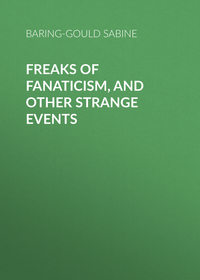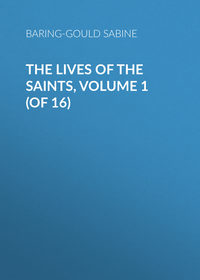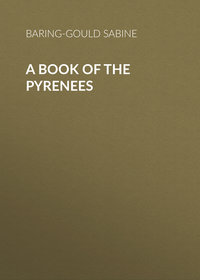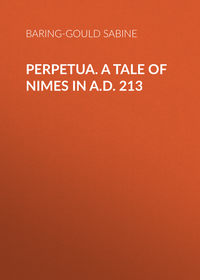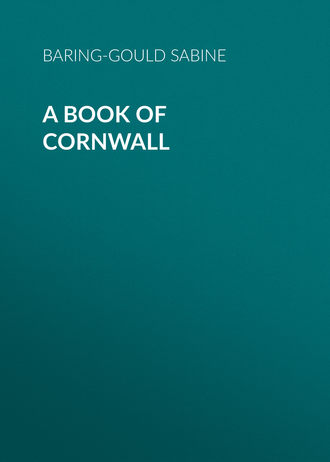 полная версия
полная версияA Book of Cornwall

S. Baring-Gould
A Book of Cornwall
CHAPTER I
THE CORNISH SAINTS
A saint or squab pie-The saints belong to five classes-I. The members of the royal Dumnonian family-II. Irish-Welsh colonists-The invasion of Brecknock-Brychan-The invasion of Cornwall and Devon-Murtogh Mac Earca-III. Irish in West Cornwall-IV. Welsh-Breton saints-V. Pure Breton importations-Ecclesiastical colonies-Llans and cells-Tribal organisation-Ecclesiastical also tribal-The sanctuary-How a tribe was recruited-Jurisdiction-What a Celtic monastery was-Rights exercised by the saints-That of ill-wishing-Missionary methods of the Celtic saints-Illand and S. Bridget-The power of the keys as the saints understood it-Reciprocal rights-The saint expected to curse the enemies of the secular tribe-Asceticism-A legal process carried into religion-Story of the three clerks-A higher idea of asceticism gained ground-S. Columba and the nettles-The saints and animals-And children-How they used their powers-What they did for womankind-The biographies, how far trustworthy-The interest in knowing something of the founders of the Churches.
The story goes that the devil one day came to the Tamar from the Devon side and stood rubbing his chin and considering.
"No," said he, "I won't risk it. Yonder every person is made into a saint, and everything into squab pie. I do not feel qualified for either position."
And it is a fact that nowhere else in England are there so many villages bearing the names of saints, and these names strange, and such as may be sought out in vain in the calendars that are easily accessible. One is impressed with the idea that the vast majority of these saints are unknown and negligible quantities.
This, however, is an entirely false assumption, and it is based on the fact that their history has not been studied.
On close examination it will be found that the saintly names in Cornwall belong to certain well-defined groups, and when we have determined the localities occupied by these groups we have taken the first step towards the elucidation of some important problems in the early history of Cornwall.
Now let us look at these groups.
I. The first belongs to members of the royal Dumnonian family that ruled Devon and Cornwall.
The first-known prince was Constantine the Blessed (about 460), whose brother Aldor migrated to Brittany, and married the sister of Germanus of Auxerre, who came to Britain in 429 and 447 to oppose the spread of the Pelagian heresy.
Constantine's son Erbin, prince of the Dumnonii, died about 480. We know nothing of him save that he was the father of Geraint, the heroic king who fell at Langport, in Somersetshire, in 522, fighting against the Saxons.
His name is familiar to us as the husband of Enid, daughter of the lord of Caerleon, whose virtues and pathetic story have been revived with fresh interest in Tennyson's idyl. Geraint has left his name at Dingerrein, where was his palace, near the church he founded-S. Gerrans, in Roseland-and a tomb, supposed to be his, is still pointed out. Although his story is preserved in the Mabinogion, this story has no pretence to be regarded as history.
His first cousin was Gwen of the Three Breasts, married to Fragan, also a cousin, who migrated to Brittany. There is a curious monument of Gwen in Brittany, on which she is actually represented as having three breasts. But the expression three-or four-breasted was used of a woman who was married thrice or four times, and had a family by each husband. The mother of S. Domangard was called the four-breasted for no other reason than this.
Fragan and Gwen had three sons-Winwaloe, Wethenoc or Winock, and James-and although the great field of their labours was in Brittany, yet they certainly visited their cousins in Cornwall and obtained grants of land there, for they founded churches in two districts, where their names remain to this day somewhat disguised in Gunwalloe, Lewanick, and Jacobstow. Geraint and Enid had several children; the eldest was Solomon or Selyf, who died about 550.
He married Gwen, sister of Non, the mother of S. David, and it was due to this connection that Non and her son came to Cornwall and founded Altarnon, Pelynt, and Davidstowe.
Gwen herself we recognise as S. Wenn; she was the mother of S. Cuby, founder of Duloe and Tregony. Docwin or Cyngar, brother of Solomon, was an abbot in Somersetshire. In his old age his nephew Cuby took his uncle with him to Ireland, where he kept a cow for providing the old man with her milk. A chief carried off the cow, and Cuby left Ireland and brought the aged uncle back with him. Docwin or Cyngar was the founder of S. Kew.
Again, another uncle of S. Cuby was Cado, Duke of Cornwall, who makes a great figure in Geoffrey of Monmouth's fabulous history, and in the Arthurian romances. He was father of Constantine, whom Gildas attacked so venomously in his spiteful letter about 547, and who was converted by S. Petrock in his old age. We have in Cornwall two of his foundations and one in Devon.
After his conversion Constantine went to Ireland and entered a monastery without disclosing who he was. He was discovered by accident; for, having been set to grind corn with a hand-quern, he was overheard laughing and saying, "What would my Cornish subjects think were they to see me thus engaged?"
II. The second group of saints is of Irish-Welsh origin. The Welsh have a droll legend to account for the Irish conquest of Brecknock.
Meurig, king of Garth-Madrin (a part of Brecknockshire), had a daughter, Marchell, who said to her father in coaxing terms, "I do want a fur cloak; the winters here are abominably cold."
"You shall have one," answered the father.
On cool reflection Meurig considered that fur cloaks were expensive luxuries, far beyond the means of a petty Welsh prince.
So he said to Marchell, "My dear, I am going to marry you to a very agreeable young man, Aulac" (Amalgaidh), "an Irish prince, and he has ample means at his disposal to provide you with the desired fur cloak."
So Aulac was invited over, found Marchell charming, and carried her back with him to Ireland.
Now whilst he was in Wales he had allowed his eyes to wander, and he had seen that there was a good deal of rich and covetable land there. So he speedily returned at the head of a host of Irish kernes, and overran, not Brecknock alone, but all Cardigan, Carmarthen, and Pembroke, and established himself as prince there.
Whether Marchell ever got her fur cloak history does not say.
Aulac and Marchell had a son, Brychan (the Speckled or Tartan-clad), who has given his name to the county of Brecknockshire.
Brychan was a much-wived man, unless he be greatly misrepresented, and had a numerous family.
Not only do the Welsh genealogists give him forty-nine children, but the Irish, the Cornish, and the Bretons attribute to him several more.
The fact is that all Brychan's family, grandchildren as well as children, have been run together, for all such as exercised tribal rights formed the family clan.
In one of the S. Neot's windows may be seen good old Brychan seated on a throne, holding a lapful of progeny before him, dense as young rabbits.
In Ireland the tribes are called after the founder, as the Hy Conaill, Hy Fiachra, or sons of Conal, sons of Fiech, though grand, great-grand, and great-great-grandchildren.
Now the Irish who had invaded South Wales were not allowed a peaceful time in which to consolidate their power, for in the time of the grandchildren of Brychan, if not in that of his son Cledwyn, king of Carmarthen, there came down a Northern Briton, named Dyfnwal, into South Wales and drove them out, and pretty well exterminated the family of Cledwyn. This must have been about the year 500, and it was probably due to this that so many of Brychan's sons and daughters and grandchildren took to their heels and crossed the Severn Sea, and established themselves in North Devon and Cornwall.
It was not till about fifty years later that Caradoc Strong-i'-th'-Arm, the son of a granddaughter of Brychan and prince of Gallewig, the region about Callington, marched westward from the Severn, and expelled the invaders, and recovered Brecknockshire.
When the great migration took place it comprised not only the family of King Brychan, but also the Gwentian royal family, that was allied to it by blood.
Of course there has accumulated a certain amount of legend about Brychan, and we cannot really be sure that such a person ever existed; that, in fact, the name is not really that of a clan, for Breogan, which is the same as the Welsh Brychan, was the reputed ancestor of one of the branches of the Scots or Irish who migrated, according to legend, from Spain to the Emerald Isle.1
What is true is that a certain Irish clan did invade and occupy Brecknock and Carmarthen, as well as Pembrokeshire, and that about 530 they were driven out of the two first counties, and that they thereupon invaded and occupied North-East Cornwall from Padstow harbour, and the north of Devon as far as Exmoor. This was not by any means a first descent. The whole coast had been a prey to invasions from Ireland for two centuries. On this occasion among the Irish-Welsh from Gwent and Brecknock came a great number of saints, that is to say, princes and princesses devoted to the ecclesiastical profession. The significance of this I shall explain presently.
I will here only point out that almost all the foundations of churches in North-east Cornwall were made by members of the same Gwent-Brecknock family. Is there, it may be asked, any Irish record of this invasion? We have a good many records of earlier forays and occupations of Britain by the Irish, but of this particular one only a somewhat confused legend. There was a certain Princess Earca, married to a king named Saran, in Ireland, who was much engaged in raids in Britain. She was the daughter of Loarn, king of Alba or Scotland, from whom Lorn takes its name, the date of whose birth is given by the Irish annalists as taking place in 434. He was, in fact, one of the Irish Ulster adventurers who invaded Scotland.
Earca ran away from her husband to be with Murtogh, a distant cousin of Saran, and she bore him four sons. The most noted of all was Murtogh MacEarca, who in time became king of Ireland. Saran then married Earca's sister, and by her became the father of S. Cairnech and Lurig, king of the Scots (Irish) in Britain. Murtogh having committed several murders in Ireland, fled for protection to his grandfather, Loarn, in Alba, and murdered him. Thereupon he was banished from what we now call Scotland. He went to his cousin S. Cairnech to bless his arms, as it was his intention to offer his services to one of the kings of Britain, and do as much fighting as came in his way. Before leaving Cairnech he murdered in cold blood his cousin Luirig, and carried off his wife.
In Britain this ruffian, we are told, became the father of Constantine and Goidel Ficht, who became the reigning princes in Cornwall.
Murtogh was back in Ireland in 488, for we find him there fighting; and he remained there stirring up strife, and a cause of bloodshed till he was elected king of Ireland in 508.
Now, Murtogh most certainly when he went to Britain led a body of adventurers like himself. He is said to have been the father of Goidel Ficht, who remained there as sovereign. Now, Goidel Fichti signifies the Irish Picts, neither more nor less, a generic name, and his fatherhood of the Irish Picts means no more than that his clan or horde, which swooped down on Cornwall and Wales, regarded themselves as Hy Murtogh.
It is rather remarkable that his cousin, the whole brother of S. Cairnech, was named Broechan or Brychan.
Now, in this story, attached to a perfectly historical character, I cannot but suspect that we have a reference to a descent on Wales and Cornwall in or about 470-480.
Perhaps it may interest the reader to hear what was the end of this ruffian.
On his return to Ireland he brawled and fought till he became king in 508.
He was married to a good wife named Duiseach, and had by her a family, but he fell under the fascinations of a beautiful woman called Shin, whereupon he turned away his wife; and-by the witchcraft, so it was supposed, of the witch-one after another of his children was carried off by disease, possibly by poison. Duiseach fled for refuge to S. Cairnech, who blessed her and all who would take up her cause, and gathered together a body of men resolved on fighting to replace her. Cairnech gave a book and his staff to be carried to battle before the host.
Now it happened that in a battle fought in 524 Murtogh had killed Shin's father and brother, and though the beautiful woman continued to exercise her blandishments on the king, she had vowed revenge in her heart against him. She awaited her opportunity. It came on the eve of Samhain, All Hallows, when high revelry was kept in the hall at Cletty, where Murtogh was residing. She had the hall secretly surrounded by her men, and herself set fire to it. Murtogh was very drunk, the fire caught his clothes, and, unable to escape by the doors, which were guarded, he threw himself into a vat of wine to quench the flames, and so perished, partly by fire, partly by wine, in 527.
It is possible-I cannot say more-that as this incursion, mentioned by the Irish writers, took place precisely at the period of the Brychan descent, it may refer to it, and that Brychan may actually have been Murtogh's half-brother, who accompanied him to Britain to carve out for himself a kingdom.
III. The third group is likewise Irish, but unmixed with Welsh elements. This consists of a swarm, or succession of swarms, that descended about the year 500 upon the Land's End and Lizard district.
Concerning them we know something more than we do about the second group.
Happily Leland, who visited Cornwall in the reign of Henry VIII., made extracts from their legends then in existence, very scanty extracts, but nevertheless precious. Moreover, we have one complete legend, that of S. Fingar or Gwinear, written by a Saxon monk of the name of Anselm. And we have the lives of many of those who made a temporary stay in the Land's End and Lizard districts, preserved in Irish MSS.
IV. A fourth group is that of saints, half Welsh and half Breton, who made a short stay in Cornwall on their way to and fro.
According to Celtic law, all sons equally divided the inheritance and principalities of their father. The consequence was that on the death of a king the most masterful of his sons cut the throats of such of his brothers as he could lay hold of. And as these little games were enacted periodically in Brittany, the breath was no sooner out of the body of a prince than such sons as felt that they had no chance of maintaining their rights made a bolt of it, crossed into Cornwall, and either halted there or passed through it on their way to Wales, where they very generally got married.
Then either they or their sons returned to Cornwall and lingered there, watching events in Brittany for the safe moment to go back and reassert their rights, and as they rarely could recover princely rights, they became ecclesiastics; a compromise was effected, and they were allowed to return and set up as founders of saintly tribes.
Whilst they tarried in Cornwall they occupied their leisure in founding churches.
Such was S. Samson, with his disciples S. Mewan, S. Austell, and S. Erme.
Such again was S. Padarn, who established a large settlement where are the Petherwins.
When Samson crossed from Wales to Cornwall on his way to Brittany, he sent word to Padarn that he was going to visit him. They were first cousins. Padarn heard the news just as he had left his bed, and had pulled on one shoe and stocking. So delighted was he to hear that Samson was approaching that he ran to meet him with one leg and foot shod and the other bare.
Samson founded churches at Southill and Golant.
V. A fifth group consists of importations. In the year 919 or 920, on account of the devastations of the Normans, Brittany was almost depopulated. The Count of Poher fled with a number of his Bretons to Athelstan, and he took with him Alan his son, afterwards called Barbe-torte, who was Athelstan's godson. At this date Athelstan could do little for them; he did not ascend the throne till 924, and it was not till 926 that he defeated Howel, king of the West Welsh, as the Cornish and Devon Britons were called, and forced him to submission. In 935 Athelstan passed through Cornwall to Land's End and Scilly, and possibly enough he may have then allowed some of these fugitive Bretons to settle in Cornwall; and this explains the existence there of churches bearing the names of merely local and uninteresting saints, as S. Meriadoc at Camborne, S. Moran, and S. Corentin of Cury. These foundations mean no more than that some of the Breton settlers had brought with them the relics of their patrons in Rennes, Nantes, and Quimper. But an early Celtic foundation had quite another meaning. Among the Celts churches were not generally called after dead saints, but after their founders. The process of consecration was this: -
A saint went to a spot where a bit of territory had been granted him, and fasted there for forty days and nights, and continued instant in prayer, partaking of a single meal in the day, that plain, and indulging in an egg only on Sundays. At the conclusion of this period the llan or cell was his for ever inalienably, and ever after it bore his name. Moreover, among Celtic saints there existed quite a rage after multiplication of foundations, daltha churches, as they were called. Unless a saint could point to his baker's dozen of churches founded by himself, he was nought. But not all churches bearing a saint's name, say that of Petrock, were founded by him in person. A saint was supposed never to die, never to let go his hold over his territory. And when in after-years a chief surrendered land to a monastery, he gave it, not to the community, but to the saint; and the church built on that land would bear the name of the saint whose property it was.
The reader may like to hear something about the organisation of the Church in Celtic lands. But to understand this I must first very shortly explain the political organisation.
This among all Celtic people was tribal. The tribe, cinnel, clan, was under a chief, who had his dun or fort. Every subdivision of the tribe had also its camp of refuge and its headman.
When the British became Christian, Christianity in no way altered their political organisation. This we may see from the conduct of S. Patrick, who converted the Irish. He left their organisation untouched, and accommodated his arrangements for the religious supervision of the people to that, as almost certainly it existed in Britain, except perhaps in the Roman colonial cities.
Now this was very peculiar, quite unlike anything that existed in the civilised Roman world.
This organisation consisted in the creation of an ecclesiastical tribe side by side with the tribe of the land. The saint was given by the king or chief a certain territory, and at once he set to work thereon to constitute an ecclesiastical tribe subject to his rule, precisely similar to the secular tribe subject to the rule of the chieftain. A rill of water usually divided the two settlements. The idea of the church and the priest in the midst of the tribe of the land, acting as chapel and chaplain did to the Saxon thane or the Norman baron, did not occur to the Celt. The two tribes coexisted as separate units, but tied together by reciprocal rights.
The saint having been given a bit of land, at once constituted his sanctuary. He put up stones or crosses marking his bounds, a thousand paces from his cell, in a circle.
Every noble, arglwyd, or flath exercised rights of sanctuary, and the extent of his sanctuary constituted his llan, or lawn. The lowest grade of noble had the limits of his lawn marked at the distance of three throws of a spear or a ploughshare from his door; the rig or king had his as far as sixty-four pitches.
Now all those who took refuge within the lawn had sanctuary for a limited period, and the noble or the saint employed this time of respite to come to terms with the prosecutor, and furnish the fine (eric) appointed by law for the offence committed by the refugee. If he could not pay the fine he surrendered the man who had come for sanctuary, but if he paid it, thenceforth that man became his client, and he provided him with a bod or both, a habitation, and land to cultivate; he became one of his men. This was an important means whereby the saint recruited his tribe.
Throughout Cornwall a number of sanctuaries, remain, under the name of "sentry fields." If we could find out how many and where they are, we should know what were the mother llans of the early saints.
But a saintly tribe was recruited in another way. Every firstling of the secular tribe was made over to the saint: the first son of a family, the first lamb and calf. The son did not necessarily become an ecclesiastic, but he passed into the ecclesiastical tribe, and became subject to the jurisdiction of the saint.
But it may be asked, What happened when the saint died?
Every chief had his taanist, or successor, appointed during his life, and enjoying certain privileges. So every saint had his coarb chosen to rule in his name, his steward, his representative on earth. Here came in an usage very strange to Latin minds. The coarb must be of the royal or chieftain's race, and the right to rule in the ecclesiastical tribe belonged to the founder's family, and was hereditary, whether he were in ecclesiastical orders or not, to a female as well as to a male. Thus, although in an ecclesiastical establishment there was always a bishop to confer orders, he did not exercise jurisdiction. The rule was in the hands of the head of the sacred tribe. Thus S. Bridget kept her tame bishop, Conlaeth, who was wholly under petticoat government. He did kick once, and was devoured of wolves as a judgment, having strayed, against Bridget's orders, among the mountains. S. Ninnocha had as many as four bishops under her command. Bishop Etchen was subject to the jurisdiction of S. Columba, who was in priest's orders.
The Celtic Church as we know it, till gradually brought under Roman discipline, was purely monastic. The monasteries were the centres whence the ministry of souls was exercised. Within the sanctuary a rampart was thrown up, generally of earth, and within this was the church, and about it the separate circular cells occupied by the monks. Outside the sanctuary and throughout the lands belonging to the saint lived those subject to the rule of the saint or his coarb.
There was a right exercised by the saint which had previously been accorded to the bard. It was that of ill-wishing. The right was a legal one, but hedged about with restrictions. A bard, and after him a saint, might not ill-wish unless he had been refused a just request. If he ill-wished unjustly, then it was held that the ill-wish returned on the head of him who had launched it.
And there can be no doubt that this legal power conferred on the saints inspired terror. If a chief's horse fell under him, or his cows refused their milk, if he got a bad cold or rheumatic pains, he immediately supposed that he had been ill-wished, and sent for the saint, and endeavoured to satisfy him.
That this supposed power may have been employed occasionally for ambitious purposes is likely enough, but in general it was exercised only for good, to release captives, to mitigate barbarities, to stay bloodshed, to protect the weak against the strong.
A cheap and easy way of explaining the exercise of this power by the saints is that of saying that they traded on the credulity of the people. But it is, I am sure, a false appreciation. They were of the people, steeped in their ideas, and did not rise above them. To trade on credulity implies a superiority they did not possess. Besides, it was the exercise of a formal legal right.
There is one rather significant feature in all the missionary work of the Celtic saints which contrasts sharply with that of our modern emissaries into "foreign parts."



